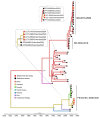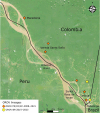Co-Circulation of 2 Oropouche Virus Lineages, Amazon Basin, Colombia, 2024
- PMID: 39356574
- PMCID: PMC11521167
- DOI: 10.3201/eid3011.240405
Co-Circulation of 2 Oropouche Virus Lineages, Amazon Basin, Colombia, 2024
Abstract
In early 2024, explosive outbreaks of Oropouche virus (OROV) linked to a novel lineage were documented in the Amazon Region of Brazil. We report the introduction of this lineage into Colombia and its co-circulation with another OROV lineage. Continued surveillance is needed to prevent further spread of OROV in the Americas.
Keywords: Amazon Basin; Colombia; Leticia; Oropouche virus; fever; lineages; outbreak; reassortant; reassortment; sequencing; vector-borne infections; viruses; zoonoses.
Figures



References
MeSH terms
Supplementary concepts
LinkOut - more resources
Full Text Sources

